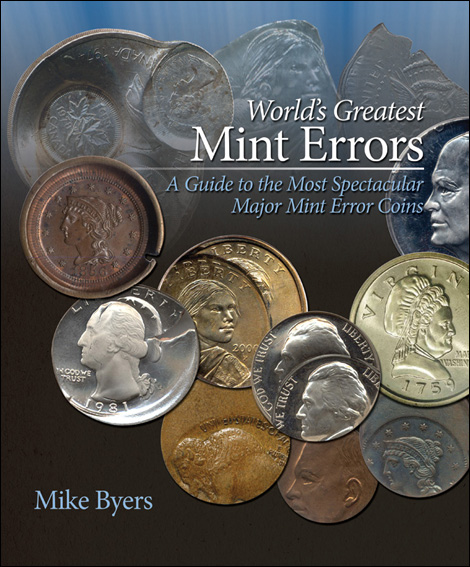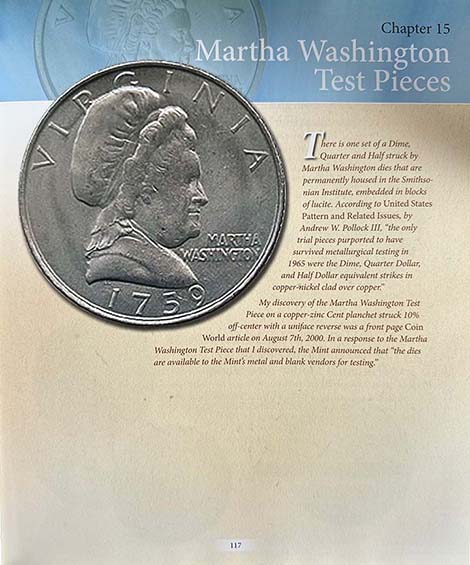 A collector and reader of Mint Error News just purchased the second known Martha Washington Obverse Die from Mike Byers Inc. This die was used to strike half dollar experimental test pieces for U.S. Judd #2131-2143.
A collector and reader of Mint Error News just purchased the second known Martha Washington Obverse Die from Mike Byers Inc. This die was used to strike half dollar experimental test pieces for U.S. Judd #2131-2143.
 There are only three Martha Washington Half Dollar-Sized Uncancelled Obverse Dies in private hands, two mint state and one proof. There is only one proof Martha Washington Half Dollar-Sized Uncancelled Reverse Die known in private hands. This half dollar obverse Martha Washington Die was featured on the cover of Mint Error News Magazine Issue #44 (Spring 2018).
There are only three Martha Washington Half Dollar-Sized Uncancelled Obverse Dies in private hands, two mint state and one proof. There is only one proof Martha Washington Half Dollar-Sized Uncancelled Reverse Die known in private hands. This half dollar obverse Martha Washington Die was featured on the cover of Mint Error News Magazine Issue #44 (Spring 2018).
Editor's Note: Below are images of the first known Martha Washington Obverse Die and the original article that was previously published in Mint Error News Magazine.
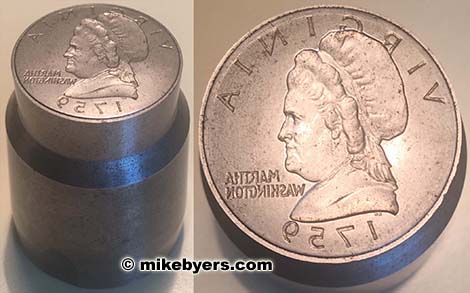
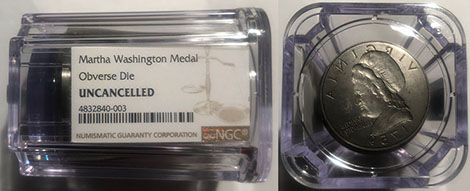
 I discovered the first known Martha Washington Test Pieces, of ANY denomination in 2000. It was struck on a U.S. cent planchet. Coin World featured this discovery on their front page on August 7th, 2000.
I discovered the first known Martha Washington Test Pieces, of ANY denomination in 2000. It was struck on a U.S. cent planchet. Coin World featured this discovery on their front page on August 7th, 2000.
 Since then, there have been Martha Washington Test Pieces struck on the 5c, 10c, 25c, 50c and $1 size denominations. Different metal compositions and surfaces were used in these experimental test pieces.
Since then, there have been Martha Washington Test Pieces struck on the 5c, 10c, 25c, 50c and $1 size denominations. Different metal compositions and surfaces were used in these experimental test pieces.
Below are the Martha Washington Test Pieces that I discovered in 2000:
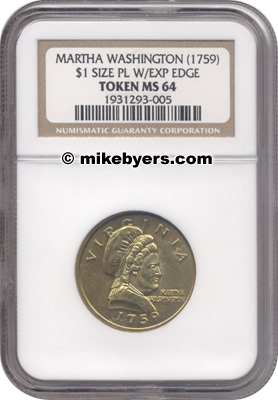
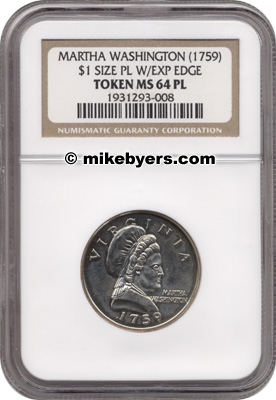

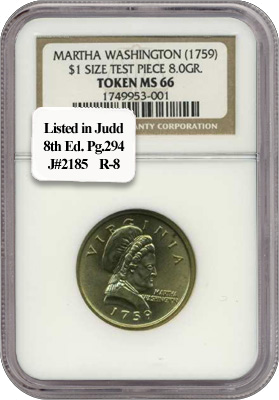
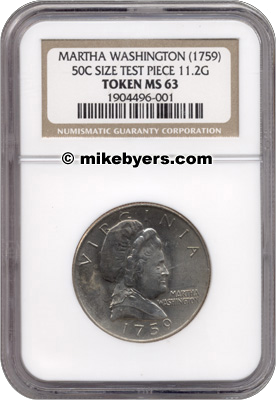


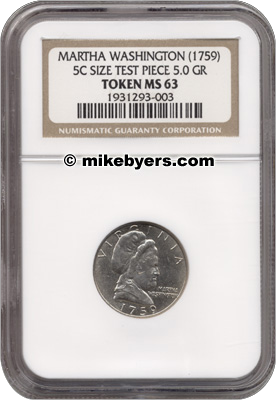

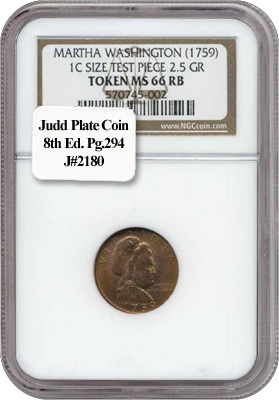
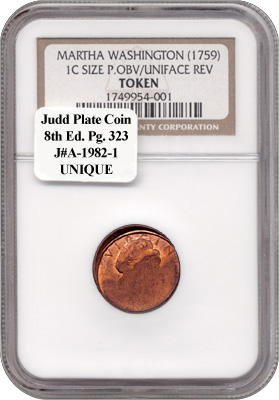
 The U.S. Mint conducted metallurgical tests in 1999 on the golden colored manganese-clad planchets which would later be used for the Sacagawea Dollar. Click here for more info on the Brass Dollar Planchet from uspatterns.com.
The U.S. Mint conducted metallurgical tests in 1999 on the golden colored manganese-clad planchets which would later be used for the Sacagawea Dollar. Click here for more info on the Brass Dollar Planchet from uspatterns.com.
 For the first time, the U.S. Mint included representatives from Industry because the new Sacagawea Dollar would have to be completely interchangeable with the existing SBA Dollar. The electromagnetic fingerprint had to be identical. All of the metals combined changed the alloy's electromagnetic properties. Many tests were conducted including those at IDX Inc., Olin Brass and PMX Industries.
For the first time, the U.S. Mint included representatives from Industry because the new Sacagawea Dollar would have to be completely interchangeable with the existing SBA Dollar. The electromagnetic fingerprint had to be identical. All of the metals combined changed the alloy's electromagnetic properties. Many tests were conducted including those at IDX Inc., Olin Brass and PMX Industries.
 In a Coin World article on July 16th, 2001, James Halsey, President of IDX Inc. was interviewed. IDX Inc. is one of the firms contracted by the U.S. Mint to test prototypes. Mr. Halsey said "numerous samples in different alloys bearing the Martha Washington obverse and Mt. Vernon reverse dies - special designs used for experimental coinage - were shipped to IDX Inc. for testing. Some of the packages were insured for as high as $250,000, with the recipients required to return any and all pieces supplied by the Mint for tests."
In a Coin World article on July 16th, 2001, James Halsey, President of IDX Inc. was interviewed. IDX Inc. is one of the firms contracted by the U.S. Mint to test prototypes. Mr. Halsey said "numerous samples in different alloys bearing the Martha Washington obverse and Mt. Vernon reverse dies - special designs used for experimental coinage - were shipped to IDX Inc. for testing. Some of the packages were insured for as high as $250,000, with the recipients required to return any and all pieces supplied by the Mint for tests."
 Two other firms under contract by the U.S. Mint include Olin Brass and PMX Industries. Both of these companies supply the U.S. Mint with the manganese-clad strips from which the Sacagawea Dollars are struck. Olin Brass is a leading U.S. copper alloy producer and is located in East Alton, Illinois. PMX Industries is located in Cedar Rapids, Iowa.
Two other firms under contract by the U.S. Mint include Olin Brass and PMX Industries. Both of these companies supply the U.S. Mint with the manganese-clad strips from which the Sacagawea Dollars are struck. Olin Brass is a leading U.S. copper alloy producer and is located in East Alton, Illinois. PMX Industries is located in Cedar Rapids, Iowa.
 According to a Coin World article in the June 24, 2002 issue, "anti-tarnish tests were conducted at the Philadelphia Mint on January 8, 2000, on Sacagawea dollar blanks struck with the experimental Martha Washington obverse, Mount Vernon reverse experimental dies, according to Mint e-mails." The article continued: "Seven processes were explored: one on circulation quality strikes, three on Uncirculated [Mint set] quality coins, and three on Proof quality strikes. The coins were struck on at least four different kinds of presses, with the blanks subjected to one of five burnishing methods."
According to a Coin World article in the June 24, 2002 issue, "anti-tarnish tests were conducted at the Philadelphia Mint on January 8, 2000, on Sacagawea dollar blanks struck with the experimental Martha Washington obverse, Mount Vernon reverse experimental dies, according to Mint e-mails." The article continued: "Seven processes were explored: one on circulation quality strikes, three on Uncirculated [Mint set] quality coins, and three on Proof quality strikes. The coins were struck on at least four different kinds of presses, with the blanks subjected to one of five burnishing methods."
 I discovered one of the three known Martha Washington Test Pieces struck on a Sacagawea Dollar planchet. It was certified by NGC as a dollar-sized test piece weighing 8.0 grams and was graded MS 66. It is listed as Judd #2185 on page 294 of eighth edition of United States Pattern Coins, Experimental and Trial Pieces.
I discovered one of the three known Martha Washington Test Pieces struck on a Sacagawea Dollar planchet. It was certified by NGC as a dollar-sized test piece weighing 8.0 grams and was graded MS 66. It is listed as Judd #2185 on page 294 of eighth edition of United States Pattern Coins, Experimental and Trial Pieces.
 A Martha Washington Half Dollar struck on a clad Quarter planchet sold for $29,900 in a Heritage Auction at the 2003 Mid-Winter ANA. Click here for more info on the Martha Washington Half Dollar from uspatterns.com.
A Martha Washington Half Dollar struck on a clad Quarter planchet sold for $29,900 in a Heritage Auction at the 2003 Mid-Winter ANA. Click here for more info on the Martha Washington Half Dollar from uspatterns.com.
 I discovered the first Martha Washington Test Piece struck on a clad Quarter planchet. This coin is the plate coin for Judd #2115 on page 290 of the eighth edition of United States Pattern Coins, Experimental and Trial Pieces. Recently a second Martha Washington Quarter has been discovered. Click here for more info on the Martha Washington Quarter from uspatterns.com.
I discovered the first Martha Washington Test Piece struck on a clad Quarter planchet. This coin is the plate coin for Judd #2115 on page 290 of the eighth edition of United States Pattern Coins, Experimental and Trial Pieces. Recently a second Martha Washington Quarter has been discovered. Click here for more info on the Martha Washington Quarter from uspatterns.com.
 The first Martha Washington Dime Trial Piece in private hands sold for $51,750 at the 2003 Baltimore ANA. NGC authenticated and encapsulated this Martha Washington Dime in April of 2000. The second Martha Washington Dime Trial Piece is in the Heritage Galleries 2007 January Orlando, FL (FUN) Signature Coin Auction #422. It was certified AU 58 by NGC and is struck in cupronickel-copper (multi-layer composite). Click here for more info on the Martha Washington Dime from uspatterns.com.
The first Martha Washington Dime Trial Piece in private hands sold for $51,750 at the 2003 Baltimore ANA. NGC authenticated and encapsulated this Martha Washington Dime in April of 2000. The second Martha Washington Dime Trial Piece is in the Heritage Galleries 2007 January Orlando, FL (FUN) Signature Coin Auction #422. It was certified AU 58 by NGC and is struck in cupronickel-copper (multi-layer composite). Click here for more info on the Martha Washington Dime from uspatterns.com.
 According to United States Pattern and Related Issues, by Andrew W. Pollock III, "the only trial pieces purported to have survived metallurgical testing in 1965 were the Dime, Quarter Dollar, and Half Dollar equivalent strikes in copper-nickel clad over copper." There is one set of a Dime, Quarter and Half struck by the Martha Washington dies that are permanently housed in the Smithsonian Institute, embedded in blocks of lucite. Click here to view the Martha Washington patterns permanently housed in a block of lucite at the Smithsonian.
According to United States Pattern and Related Issues, by Andrew W. Pollock III, "the only trial pieces purported to have survived metallurgical testing in 1965 were the Dime, Quarter Dollar, and Half Dollar equivalent strikes in copper-nickel clad over copper." There is one set of a Dime, Quarter and Half struck by the Martha Washington dies that are permanently housed in the Smithsonian Institute, embedded in blocks of lucite. Click here to view the Martha Washington patterns permanently housed in a block of lucite at the Smithsonian.
 I also discovered a Martha Washington Test Piece struck on a copper-zinc Cent planchet. This Martha Washington Test Piece might have been used to test the new copper-zinc planchets for the U.S. Mint in 1982. This coin is the plate coin for Judd #2180 on page 294 of the eighth edition of United States Pattern Coins, Experimental and Trial Pieces. Starting in 1982 the composition and weight of the Cent planchet changed. Instead of weighing 3.11 grams and having a composition of 95% copper and 5% zinc, the weight is 2.5 grams with a composition of 97.5% zinc and 2.5% copper. Click here for more info on the Martha Washington Cent from uspatterns.com.
I also discovered a Martha Washington Test Piece struck on a copper-zinc Cent planchet. This Martha Washington Test Piece might have been used to test the new copper-zinc planchets for the U.S. Mint in 1982. This coin is the plate coin for Judd #2180 on page 294 of the eighth edition of United States Pattern Coins, Experimental and Trial Pieces. Starting in 1982 the composition and weight of the Cent planchet changed. Instead of weighing 3.11 grams and having a composition of 95% copper and 5% zinc, the weight is 2.5 grams with a composition of 97.5% zinc and 2.5% copper. Click here for more info on the Martha Washington Cent from uspatterns.com.
 In August of 2000, I discovered a Martha Washington Test Piece on a copper-zinc Cent planchet that was struck 10% off-center with a uniface reverse. This discovery was a front page Coin World article on August 7th, 2000. In a response to the Martha Washington Test Piece that I discovered, the Mint announced that "the dies are available to the Mint's metal and blank vendors for testing." This die trial piece was discovered by a Brinks employee. It is in gem mint state condition with red and brown toning. The obverse design of the die features a bust of Martha Washington facing right. In the right field is the inscription MARTHA WASHINGTON. Above the portrait is VIRGINIA and below the date 1759.
In August of 2000, I discovered a Martha Washington Test Piece on a copper-zinc Cent planchet that was struck 10% off-center with a uniface reverse. This discovery was a front page Coin World article on August 7th, 2000. In a response to the Martha Washington Test Piece that I discovered, the Mint announced that "the dies are available to the Mint's metal and blank vendors for testing." This die trial piece was discovered by a Brinks employee. It is in gem mint state condition with red and brown toning. The obverse design of the die features a bust of Martha Washington facing right. In the right field is the inscription MARTHA WASHINGTON. Above the portrait is VIRGINIA and below the date 1759.
 The evolving story about the Martha Washington Dies, test strikes and the discovery of these pieces is among the most interesting Numismatic stories in decades.
The evolving story about the Martha Washington Dies, test strikes and the discovery of these pieces is among the most interesting Numismatic stories in decades.
Featured in Mint Error News Magazine Issue 14
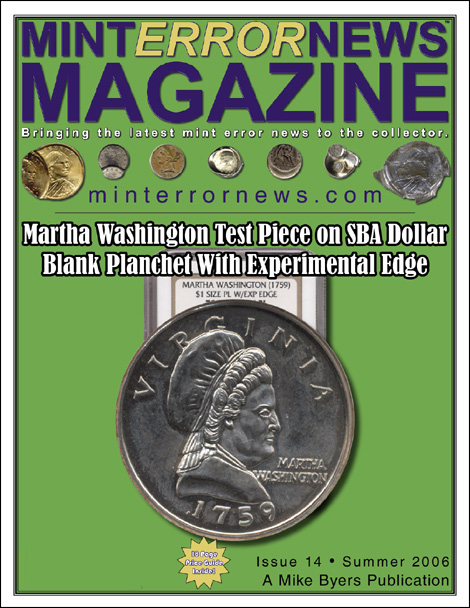
Mike Byers' discovery was featured
in a front page article in Coin World
Copyright story reprinted by permission from Page 1 and Page 16 of the August 7, 2000 issue of COIN WORLD, Sidney, OH (coinworld.com)
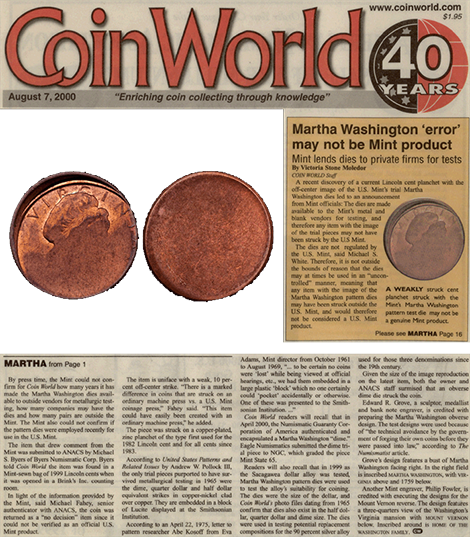
This Martha Washington Half Dollar-Sized Obverse Die is featured in the U.S. Patterns website (uspatterns.com) that references all U.S. patterns and related numismatic rarities:

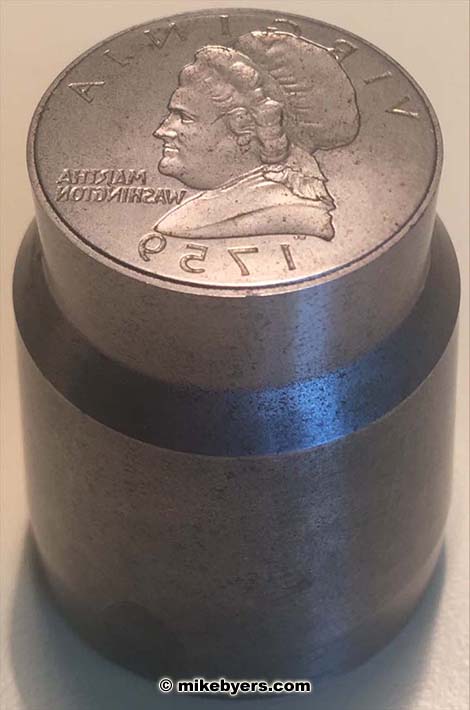
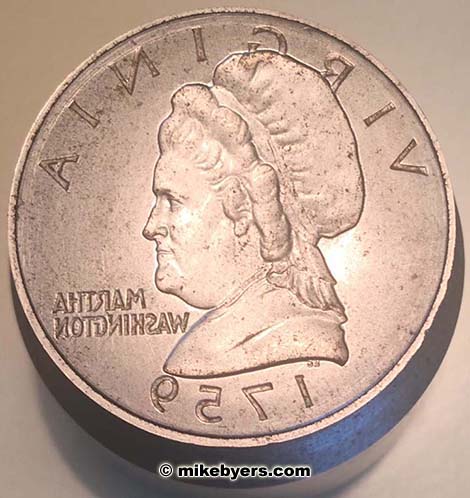
Here is the first Martha Washington
Half Dollar-sized test piece that I discovered in 2000:

The Martha Washington Test Piece discoveries
are featured in chapter 15 of the book,
World's Greatest Mint Errors:
